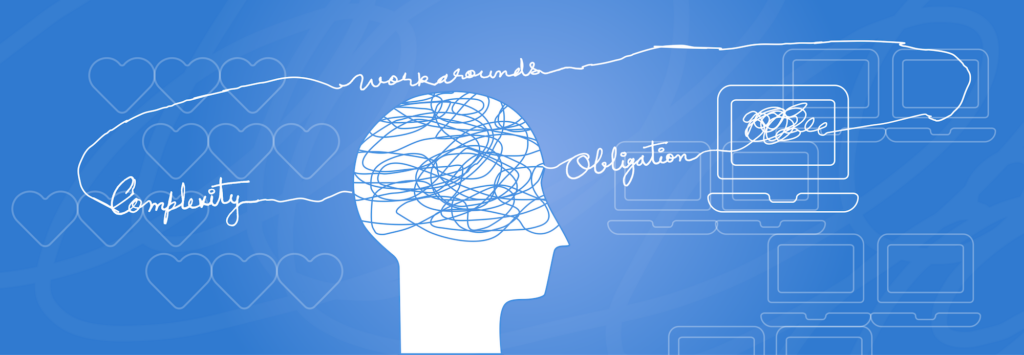How can designers reverse the complex mental models people develop from interacting with convoluted enterprise software? How can we respect the gratification people get out of executing complex tasks at work? When does simplicity actually compromise user experience?
These are some of the questions that have intrigued me as a human-centered design practitioner. The interplay between human behaviour and product experience is fascinating in the enterprise space because of its unique characteristics: Enterprise products are designed to tackle niche business problems, used to accomplish definitive tasks, and, unfortunately most often, forced on end users whether they like it or not.
In enterprise, the customer is not the end user, and usability has not generally been a key metric in purchasing decisions. As a result, most companies end up purchasing products that weren’t necessarily designed with empathy for end-users. Organizations spend millions of dollars to procure products that can support the functionality and scale of their businesses, and now that this expensive product has been bought and employees trained, it has to be used. The price and effort create a deep and long-term sense of obligation. How much does this obligation impact the intuition of end-users? Given that most of the enterprise product end-users have to use the product, and that its directly associated to their livelihood, how do we measure intuitiveness?
Historically, most enterprise applications have suffered from poor usability and user experience. The primary focus has been to build robust functional products, with an exhaustive set of features and capabilities. When users of these applications stumble into usability rabbit holes, they frequently master the art of working around such blockers. They grow conditioned and habituated into making bad usability work. Because the systems are inflexible, users engage with them in unexpected, and not always the most efficient ways through elaborate ‘work arounds’ that enable them to get their work done (Bowers et al. 1995 in Blomberg & Karasti 2013). Can product usage out of obligation create a misconception of usability?
Today, the proliferation of enterprise products on the market has made understanding behavior and attitudinal transformations of end-users more pertinent than ever. UX researchers and designers in enterprise engage in a broad spectrum of problem solving—from tangible business problems to abstract usability challenges. But when that exciting time comes to rethink or re-imagine a cumbersome, legacy experience, to replace the old with the new, we often discover resistance to adoption.
New concepts, however valuable or usable, may generate negative sentiments through conventional evaluation studies. Alone, research findings like this could make it seem imperative to move away from the disruptive solution toward one that is more aligned with users’ existing mental models. Should designers always honour established, legacy mental models? Or should enterprise products initiate new experiences that bring a heavier burden of adaptation?
As usability practitioners, we focus on optimizing task flows, reducing clicks, simplifying experiences, improving productivity, and building delight into product experiences. During my early career, when I was conducting contextual inquiries for a legacy business intelligence product, I observed an interesting pattern. The data analysts that I was shadowing brimmed with passion and interest as they walked me through the complex steps and various paths involved in using a multitude of tools to bring data into one platform. Rather than noting that as ‘pain’, I read it as ‘pleasure’. I felt that there was a sense of pride originating from the very complexity of the task, one that I was there to simplify. That posed an interesting design challenge—How do I retain this notion of delightful complexity in my designs while at the same time embracing better usability?
If I could capitalize on this emotional incentive, my designs could impact adoption. And that’s what I did. It took me several shadowing sessions to identify the anchor and incorporate that into the product experience. The resulting user experience pivoted around this emotional core, reflected a fine balance of shifting the load between the users and the system.
To design impactful human centered experiences, it is imperative to dive deeper into user psyche, behaviour, and all their influencers and motivational triggers. Should we break or transform existing conventional research methodologies to come up with newer effective methods when designing for enterprise? It is principal for practitioners to continue weighing the relationship between ethnography and design, especially with respect to new directions and challenges (Blomberg and Karasti, 2012). Would pivoting research around analogous participatory activities help identify rich behavioral anchors? Can we bring in more social and behavioral insights into user personas, and map these personas over time across behaviour and changing context?
I leave you with these questions, so that as design and research practitioners we can start thinking about and devising creative ways of blending ethnography into the design of enterprise products more effectively.
Reference
Blomberg, Jeanette & Karasti, Helena. (2013). Reflections on 25 Years of Ethnography in CSCW. Computer Supported Cooperative Work 22(4), 373–423. DOI: 10.1007/s10606-012-9183-1.
Blomberg, Jeanette & Karasti, Helena. (2012). Positioning Ethnography within Participatory Design. In Routledge International Handbook of Participatory Design, Jesper Simonsen and Toni Robertson eds, pp 86–116. Routledge.
*Editor’s Note: Salesforce is an EPIC2018 Sponsor. EPIC is a volunteer-run, nonprofit organization and the support of sponsoring organizations makes our incredible international conference possible. Conference papers, case studies, PechaKucha, ethnographic film, and gallery installations are selected through a blind peer review process managed by our conference committee, which is independent from our board and sponsors.
 Vineeth Nair is a Sr. Manager, User Experience at Salesforce. A generalist UX practitioner, he is passionate about identifying and incorporating behavioral insights into product design experiences. Vineeth is a storyteller at heart, and has experience designing across a wide spectrum from animations to products. Vineeth holds a Masters in Visual Communication from IIT Bombay, India, and also holds a Bachelors in Computer Science.
Vineeth Nair is a Sr. Manager, User Experience at Salesforce. A generalist UX practitioner, he is passionate about identifying and incorporating behavioral insights into product design experiences. Vineeth is a storyteller at heart, and has experience designing across a wide spectrum from animations to products. Vineeth holds a Masters in Visual Communication from IIT Bombay, India, and also holds a Bachelors in Computer Science.
Related
Heroic Complexity in Strategic Innovation, Tony Salvador
Bringing Attention to Problem Solving and Meaningfulness at Work, Carol Charland & Karen Hofman
Trajectories of Change in Global Enterprise Transformation, Jeanette Blomberg


0 Comments